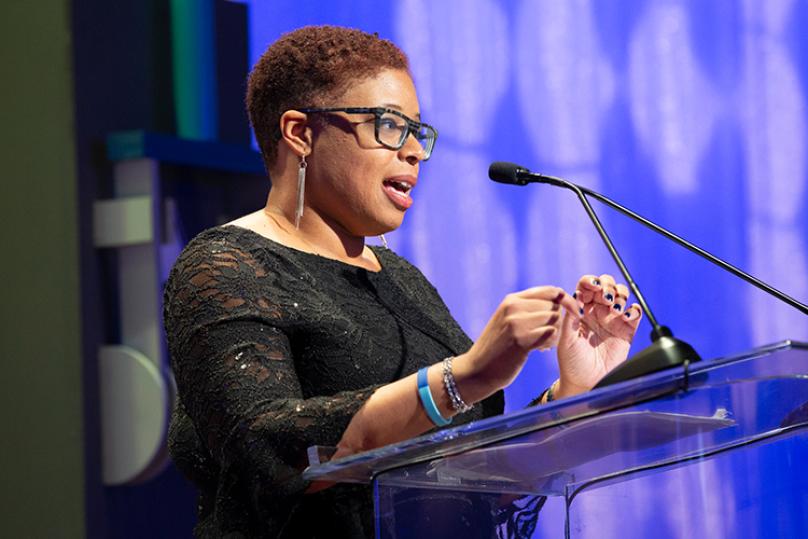
MƒA Master Teacher Sendy Keenan was the featured Master Teacher speaker at the 13th Annual MƒA Fall ƒunction. The event, held on November 9, 2019, was a way to honor and respect the entire MƒA community of over 1,000 NYC teachers who are pushing the boundaries of mathematics and science at MƒA and beyond.
Sendy called on teachers to get out of their comfort zones to truly engage students in STEM. Watch and read her inspiring speech below.
In 2004, I was sitting at my desk at my engineering job reading emails about my current project. I was a process engineer for a Fortune 100 pharmaceutical corporation, and my job, then, was to design and optimize chemical manufacturing facilities for large-scale active pharmaceutical ingredient production. Being a chemical engineer was something I wanted to do since I was in seventh grade, so I hit what I thought was the career jackpot. But, that particular afternoon, as I was replying to emails about materials of construction and pipe sizing, it hit me: this is not it. How am I contributing to society? By producing more pharmaceutical drugs? And why do so few people in this company look like me? While lucrative, and productive (I received two promotions in five years), I was not fulfilling my purpose. So, when I asked myself, “how can I affect change so that more people who look like me can be here?” I thought about how I got there in the first place. Besides the unwavering support from my family, I had amazing teachers, especially my math and science teachers! That was the next step.
Success is defined by how many other people you make successful, but a truer marker of success is having the agency to make your own decisions. After working out that I could better absorb the inevitable pay cut if I left at the end of the calendar year, I applied to the NYC Teaching Fellows program, and after being accepted, I quickly gave my notice and started out as a mid-year fellow. After more reseach, I found out about The Frederick Douglass Academy in Harlem, and I am honored to have taught math at FDA since 2005. While FDA has its own storied history, it is housed in the same building as the former I.S. 10, the middle school where a young James Baldwin cultivated his writing skills over 80 years ago. By the way, it was Baldwin’s math teacher who encouraged him to become the editor of the school newspaper, The Douglass Pilot. More on Baldwin later.
At this moment, in 2019, our education system is not equitable or just. 85 percent of the 1.1 million students in the NYC school system are students of color. We talk about the importance of inspiring them in STEM, but how often do we highlight contemporary examples of mathematicians and scientists who look like them? One example: Dr. Hadiyah Green, one of the few black women to earn a Ph.D. in physics, is currently an Assistant Professor at the Morehouse School of Medicine. Dr. Green’s current research “supports the further development of a platform cancer therapy that uses laser-activated nanoparticles to completely eliminate tumors after a single treatment,” and it currently does so with no observable side effects in lab mice.
Students of color rarely see their histories and cultures reflected in a curriculum that often portrays them as subjugates to Europeans. If they are fortunate enough, in math, to get to Calculus, our students are taught about Newton and Leibniz, but not about the contributions of mathematicians such as the tenth-century Iraqi mathematician Hasan Ibn al-Haytham, the first person known to integrate a fourth degree polynomial to find the volume of a paraboloid – and who in doing so helped lay the foundation that Europeans would later build upon. Nor are they taught about engineering marvels such as the underground carved churches in Lalibela, Ethiopia. These churches, which are still in use today, were chiseled out of solid rock, from the top down, during the 12th and 13th centuries. When these types of things are omitted – intentionally or not – all students internalize a belief, based on a false historical narrative, that contemporary and historical accomplishments in STEM are and were achieved exclusively by white men. This is why I always have to remind my students that “Math is in your DNA! Science is in your DNA! Technology is in your DNA!” No one reminded me of this fact when I was in school, and frankly, I don’t think my teachers, as good as they were, knew it, either. As an MƒA community, we have a great opportunity to do better.
“A child cannot be taught by anyone who despises him, and a child cannot afford to be fooled. A child cannot be taught by anyone whose demand, essentially, is that the child repudiate his experience, and all that gives him sustenance.”
- James Baldwin
Unfortunately there are children across NYC whose experiences are repudiated every day in school. This issue is bigger than curriculum. When our students come to school, they often receive cues that they are not valued. When teachers assume students are poor, that is a cue. When teachers celebrate a student’s success for meeting a lower standard, that is a cue. When teachers say they don’t see race, that is a cue. When students learn their teacher became an educator because their other aspirations didn’t work out, that is a cue. When students see their teachers blaming poor test scores on the fact that they work in a “failing” district, that is an especially significant cue.
In these times, we cannot afford for our young people’s minds to sit idle, for the promise of their brilliance to be stunted, or for them to be indoctrinated into a society where they are constantly reminded that they are not enough. At MƒA, we have an extraordinary opportunity and responsibility to work towards equity and justice and to cultivate curricula that does not repudiate our students’ existence. Every year alongside all of the great content offerings, there are an increasing number of pedagogical courses in the MƒA catalog dedicated to figuring out how we can help students feel strong and secure in their own cores about who they are in the world, how teachers can better recognize and build upon our students’ innate genius, and how we can responsibly prepare students to challenge the inequities that surround them. This is a great start, but too often these courses are predominantly filled with teachers of color. We are more than 1,000 teachers representing more than 400 schools, and MƒA has the power to effect real change in our education system, however we cannot challenge inequitable systems and level the playing field for our students unless we are all committed and involved. We must see all children as our own children. We must leave our comfort zones. Part of being true Master Teachers is our willingness to push ourselves to gain new knowledge in all areas of teaching, not simply those in which we feel strongest. We can, and should, do better.
I salute this talented community for its commitment to continued learning and ongoing growth, and I also challenge all of us to create a more just education system where all students are taught just as we expect our own children to be taught. Together we must ensure that schools value all our children’s greatness, elevate their abilities, provide them with the agency and choices that they deserve, honor their ancestors, and inspire a lifelong curiosity and love of learning.
